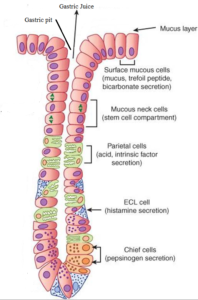Science > Biology > Digestion and absorption in Human > Gastric Glands
The gastric glands are numerous, simple or branched tubular glands present in the mucosa of the stomach. They are located in different regions of the stomach. Gastric glands secrete digestive juice and mucus. There are three types of gastric glands, distinguished from one another by location and type of secretion. The cardiac gastric glands are located at the very beginning of the stomach; the intermediate, or true, gastric glands in the central stomach areas; and the pyloric glands in the terminal stomach portion. The cardiac and pyloric glands secrete mucus, which coats the stomach and protects it from self-digestion by helping to dilute acids and enzymes. The intermediate gastric glands produce most of the digestive substances secreted by the stomach.
Cells of Gastric Glands:
Chief or Peptic (Zymogen) Cells:
These cells secrete two proenzymes: Pepsinogen and prorennin and enzymes gastric lipase and gastric amylase. As these cells produce proenzymes they are called zymogen. Zymogen means an inactive substance which is converted into an enzyme when activated by another enzyme.
Oxyntic (Parietal) Cells:
These cells secrete HCl and Castle’s intrinsic factor which helps in the absorption of vitamin B12. These cells are located in the gastric glands found in the lining of the fundus and cardia of the stomach. These cells contain an extensive secretory network called canaliculi
Globlet or Mucous Cells:
These cells secrete mucous.
Argentaffin Cells:
These cells secrete serotonin. It stimulates the constriction of smooth muscles.
Endocrine Cells or Gastrin Cells or G Cells:
They have a distinctive microscopic appearance and found in the pyloric gastric antrum; their nuclei are centrally located in the cell. They are found in the middle portion of the gastric glands. They secrete gastrin that stimulates the secretion of enzymes and HCl from gastric glands.

Gastric Juice:
Gastric juice is made up of water, electrolytes, hydrochloric acid, enzymes, mucus, and intrinsic factor. Its daily secretion is 2 to 3 litres per day. Its pH is 1.2 to 1.8. The constituents of gastric juice are
- Hydrochloric acid: It is a strong acid secreted by the parietal cells, and it lowers the stomach’s pH. It forms 0.05 to 0.3 % of gastric juice. Hydrochloric acid converts pepsinogen into pepsin and breaks various nutrients apart from the food. It also kills bacteria/germs that come along with the food.
- Pepsinogen: It is secreted by chief cells. In the presence of hydrochloric acid, it is converted to active pepsin. Pepsin breaks apart tertiary and secondary protein structures to make it easier for the digestive enzymes in the small intestines to work further.
- Gastric lipase: It is a digestive enzyme made by the chief cells. It helps break down short and medium-chain fats.
- Amylase: It is not produced by the stomach. This enzyme comes from saliva and travels along with the bolus into the stomach. Amylase breaks down carbohydrates. The activity of amylase in the stomach stops shortly due to the acidic environment in the stomach.
- Intrinsic factor: It is secreted by parietal cells and is necessary for the absorption of vitamin B-12. This vitamin is essential for a healthy nervous system function and blood cell production.
- Mucus: It is secreted by the neck cells or mucous cells and helps coat and protect your stomach lining from the acid environment.